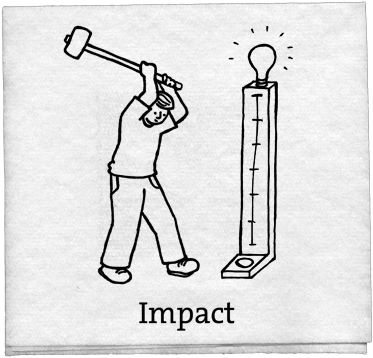Entries Tagged 'copywriting services' ↓
June 29th, 2009 — copywriting, copywriting services, freelance copywriting

Guess what? There are millions of adverts out there on websites, in newsletters, brochures, emails, TV, magazines…
So, what have you got to do to make yours stand out?
Look at what your competitors are doing…
…and then do something different.
If you study the advertising in your industry, you will probably be able to identify a common theme running through most of the ads. They may say similar things, have a similar layout or follow a similar format.
To make yours stand out you need to stand apart from everyone else.
Great. But how exactly am I supposed to do that?
Quite often you will find that because you know your industry so well, you become blinkered. Without realising it you would have fallen into the trap of churning out the same copy.
Often, when companies realise this is what’s happening, I get a call. As a freelance copywriter coming in from ‘outside’ I can look at their company with a fresh perspective. Whether I’ve worked within their particular field before or not, is neither here nor there. The fact is that I can look at the product or service with an unbiased view and produce something fresh, interesting and attention-grabbing.
Stand out and be noticed
I suppose you want a few hints now on how to make your ads more interesting. Here goes…
- Add a personal touch by using a hand written letter on your ad rather than text.
- Add a list of respected people who’ve bought from you – but make sure you get their permission first.
- Use before and after pictures to illustrate the benefits of your product.
- If you’ve had an article or review written about your company, use it in your copy – it gives respectability and credibility to your advert.
- If you offer free bonuses always add their monetary value so your readers can see what a great deal they are getting.
- If possible use a famous person to promote your product/service.
- Add your picture and contact details to your advert.
- Tell your readers that you will donate a percentage of their purchase price to a specific charity.
- Ask ‘yes’ and ‘no’ questions in your copy to remind them of their problem and to make them think about what will happen if they don’t buy your product.
- Create a competition – for example enter them in a free prize draw if they can find the 3 miss spelt words or the 5 flowers in your ad. The longer you can keep them reading the greater chance of getting them to buy.
Simply by using one or two of these suggestions in your copy, your company will be seen as standing apart from the rest. Being different is good. Being different is being seen.
June 24th, 2009 — copywriting, copywriting services, freelance copywriting

It doesn’t matter what industry you are in, you need great copy if you are going to have an impact on your market.
Whether all your marketing is offline, online, or a combination of both, your sales writing must be active, interesting, persuasive, creative and compelling if it is going to attract potential customers.
As a freelance copywriter I am approached by numerous companies from all industries looking for great sales copy. The majority of these appreciate the skill that is required to craft copy that will attract, promote and sell their products. They understand the power of professionally written copy and therefore see it as an investment.
They don’t look at my quote as an expense – they see it in terms of what the copy will produce. By investing in my services they will achieve x% higher sales and greater market visibility.
If you needed dental work, you wouldn’t get a quote, scoff at the cost and then decide to do the extraction yourself with a pair of plyers. You would know that you need a professional to ensure the best results possible.
Admittedly that example is a bit extreme, but I think it illustrates my point.
Your marketing materials are your company – they are what your potential customers will judge you on. If your brochures, website copy, newsletters, emails and reports are wishy washy, bland, boring and badly written your company will come across as that too. Utilise the services of a professional copywriter, and you will be seen as dynamic, customer centred and professional.
June 22nd, 2009 — copywriting, copywriting services, copywriting tips, freelance copywriting
A copywriter knows that to get their readers to do what they want they have to get inside their heads and understand what makes them tick.
Psychology is therefore a big part of the copywriting process.
Understanding how your reader feels, what they are looking for in life and what problems they are looking for solutions to is the real key to effective copywriting.
It sounds rather daunting, but it is something that can be easily achieved.
Put yourself in the shoes of your reader – why would they want the product you are selling? What will they get out of it? What problem could they have that would be solved by it?
OK, that may seem too much like guess work for many, so how about doing a bit of research. I am sure you know people from all walks of life, many of whom could be prospective buyers. Talk to them; ask them their opinion on the product. Tell them about it and see how they react. Ask them:
- What would make them buy?
- Why they would buy?
- What they would hope to achieve from buying it?
Armed with your newfound insight in to why they would buy, you now need to incorporate into your copy some psychological triggers that will encourage them to get out their credit cards:
- People love surprises – tell them they’ll get a surprise free bonus when ordering.
- People want an easier life – make ordering easy and give easy product instructions.
- People like security – tell them you provide a secure ordering process and privacy policy.
- People like compliments – praise them for considering your product.
- People are curious about how it will affect their lifestyle – use ‘Secret’ and ‘Confidential’ to pick their curiosity.
- People like to invest in their future – use the words ‘invest in your product’ rather than ‘buy’.
- People like to have the newest or latest things – use words like ‘new’, ‘just released’.
- People want their problems solved – tell them what problems they have and how your product will solve them.
For many people buying is an emotional action rather than a rational one. By utilising these psychological triggers you can persuade them to buy your product.
The result? Happy customers and a happy copywriting client.
Sally Ormond is a professional freelance copywriter. She has worked with numerous companies spanning a wide range of industries. Her comprehensive range of copywriting services helps her clients save time and money while increasing sales and their market visibility.
June 8th, 2009 — copywriting, copywriting services, freelance copywriting
After browsing the net the other day I came across this great post by Sherice Jacob for CopyBlogger – How To Write Copy for Short Attention Spans.
As a freelance copywriter I know all too well the problem you encounter when your audience suffers from the dreaded S.A.Ps or Short Attention Spans.
Sherice’s tips illustrate how this particular annoyance can be over come. I hope you find them useful.
No matter how gripping your sales copy is, it’s an unfortunate fact that the majority of people will only read the first few lines of it. Does that mean all the effort you poured into the perfect call to action is wasted? Not at all! But in today’s fast-paced world of communication, less really is more.
Taking into account that many people will be reading your copy from a mobile device or skimming after a quick search, it’s worth breaking up larger thoughts into small, mentally-digestible “chunks” for easy, quick scanning.
Begin With the Action in Mind
Many copywriters go about the process in reverse – filling up the valuable top left space with lofty promises no one really cares about and then spend the rest of the page getting to the product or service that’s going to bring the eventual offer.
While this type of approach is great for harnessing your long-term readers, you don’t want to alienate the visitors who are judging your site’s relevance for the first time. Some people, when they’re confronted with a long sales page, will skip right to the bottom to find out the cost, then jump right back up to the top if they feel it’s worth their time (are you nodding your head, too?)
So how do you attract the quick browser and convince them that your page is worth their time while appealing to the more serious reader who’s in it for the “long haul”?
So What?
One of the best exercises I’ve ever done to help with this process is to continually ask myself “so what?” Whittle down your copy to the raw benefits that directly engage your readers:
“XYZ company can save you up to $500 on your car insurance by helping you get a free quote online” – So what?
“Put an extra $500 in your pocket today” – Now I’m listening!
You don’t have to forego imagination for the sake of clarity either. There are some products where using the right word can make all the difference while still condensing the overall message – like so:
“XYZ chocolate makes a terrific gift. Order now for great savings and fast shipping” – So what?
“Get sinfully delicious chocolate delivered right to your door.” – I’m interested!
Strategic Chunking Retains Readers
Take a closer look at your pages – especially the very first paragraph. How can you condense and filter your message to attract the casual browser and convince them to stay? Are you making good use of headlines, sub-headlines, photos and captions? Does your call to action really call them to act or is it buried under heaps of text?
Try “chunking” your message and test it on your audience. You may be pleasantly surprised at how many more people stick around to keep reading!
June 5th, 2009 — advertising copywriting, copywriting services, freelance copywriting
 To survey or not to survey, that is the question.
To survey or not to survey, that is the question.
Well, it seems a bit daft even asking whether you should survey your customers every now and then. Surely it’s common sense to ask your buyers’ opinions about your products, your service and your sales material.
After all, sitting in your ivory tower brain storming about what you think your customers want won’t give you a true opinion. The only people that can really answer that question for you are your customers.
A good survey can tell you a lot about your market and the perception of your company within that market.
Here are 10 very good reasons why your marketing and sales strategy would benefit from regular surveying:
- Discover what your readers want to see on your web site to make them revisit and buy.
- Find out how your products can be improved opening up a whole new market for you.
- Get an insight into what products your customers would like to be able to buy in the future.
- Use the feedback to improve your customer service.
- Discover how you can make your DM and adverts more appealing.
- Raise your newsletter readership by discovering what type of articles people want to read.
- Improve the design of your web site to encourage visitors to stay there longer.
- Identify any non-related products your customers are interested in which could help you expand into different markets in the future.
- Discover how to optimise the price of your product.
- Discover the life styles of your customers – places they frequent. This could open up new marketing opportunities for you.
You can learn so much from a survey. Yes they can be time consuming, and yes they normally get pushed to the eternal bottom of the ‘to do’ pile. But I hope this has helped you see the value of the humble survey.
Seize the initiative. Devise and circulate your survey and reap the rewards of enhanced customer relationships.
Sally Ormond is a professional freelance copywriter with extensive experience in the B2B and B2C markets. Her comprehensive range of copywriting services has helped countless companies increase their sales and market visibility whilst saving them time and money.



 To survey or not to survey, that is the question.
To survey or not to survey, that is the question.




